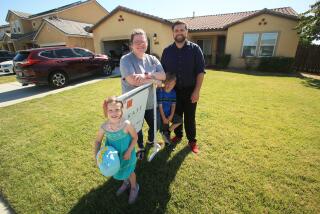Your Mortgage : ‘90s Bring a New Slate of Financing Choices : Rates: Where would-be borrowers used to choose between fixed and adjustable rates, now several new types of loans are available.
- Share via
The New Year is here, and so is a whole new slough of mortgage choices.
Gone are the days when would-be borrowers could only choose between a 30-year fixed-rate loan or an adjustable-rate mortgage. But while those industry standbys will no doubt continue to account for the lion’s share of loans that will be made in 1990, it’s a safe bet that some of the newcomers will attract their fair share of borrowers’ attention, too.
Some of the new types of mortgages are offered by several lending institutions. Others are offered only by a few.
Pasadena-based Countrywide Funding Corp., as well as Home Federal Savings & Loan and a handful of smaller lenders, recently began offering a new seven-year loan that’s amortized over 30 years.
There are a couple of benefits to this type of loan. First, although the loan is due and payable in seven years, the fact that monthly payments are based on a 30-year schedule keeps monthly payments low.
In addition, since the lender’s risk is cut by the shorter seven-year term, it can charge a lower interest rate than it does on 30-year mortgages for the same amount. Countrywide was charging 9 1/2% and 1 1/2 up-front points on its seven-year loans last week, compared to a 9 3/4% rate and 2 1/2 points on most of its standard 30-year loans.
Karen Shapiro, a spokeswoman for Countrywide, says the new loan program is attracting several types of borrowers. “It’s a good loan for people who think they’ll be ‘trading up’ into a bigger house within seven years or for corporate and military personnel who expect to be transferred within seven years.
“They’re also attracting people who want a lower interest rate than they could get on a standard 30-year loan and people who want to conserve cash by paying fewer points up-front.”
Both Countrywide and Home Federal will lend a maximum $187,450 under their seven-year programs, which means the mortgages are essentially unavailable to buyers without large down payments in many parts of the Southland’s pricey housing market.
The biggest drawback to having a loan that’s due in seven years is that you would likely have to refinance or sell your home when the seven years are up.
Countrywide gets around that potential problem by allowing the borrower to extend the loan for an additional 23 years without having to pay all the usual costs of refinancing, although the interest rate would be adjusted to reflect market rates at the time.
“If rates have gone up in seven years, you’ll be paying a higher rate than you are today,” Shapiro said. “But if rates have gone down, you’ll pay a lower rate.”
Calabasas-based ARCS Mortgage Inc. is offering a new loan that provides borrowers a little more security.
Called the “steady ARM,” the loan starts out with a 10% interest rate and stays that way for 10 years. It’s adjusted upwards or downwards at the start of the 11th year, based on changes in the 10-year Treasury bill index, and adjusted again at the start of the 21st year.
Unlike most other ARMs, the ARCS loan has no possibility of negative amortization--which means that your outstanding loan balance is guaranteed to shrink, not grow, as time goes on.
“It’s a good loan for people who don’t expect to be in their house for more than 10 years, as well as for people who want a lower rate than they would get on a fixed-rate, 30-year ‘jumbo’ loan,” said Howard Levine, president of ARCS.
Jumbo loans are loans for more than $187,450. “We’re charging 10% on the steady ARM regardless of how much you borrow, compared to 10 1/2% on jumbo loans. And if rates are lower 10 years from now, you’ll get a lower interest rate without having to pay to refinance,” Levine said.
Other types of offbeat loans are being introduced, or at least becoming more widely available.
For example, lending giants Great Western Bank and Home Savings of America--in addition to a few smaller lenders--are now offering 40-year adjustable-rate mortgages. “They’re for people who want to keep their monthly mortgage payments as low as possible,” said Sam Lyons, Great Western’s senior vice president.
Stretching payments out over an extra 10 years doesn’t just lower the loan’s monthly carrying costs, Lyons said. It also makes it a bit easier for cash-strapped borrowers to qualify for the loan and lets well-heeled buyers get a bigger loan to buy a nicer house.
The mortgages are also popular with some rental property investors who want to keep their expenses low to maximize monthly cash flow, Lyons said.
Borrowers who take out a $200,000, 40-year ARM at Great Western’s current introductory rate of about 8% would initially pay about $1,390 in monthly principal and interest payments. If they opted for a 30-year pay-back schedule, their monthly payment would be about $78 higher.
Although the longer-term loans may appeal to some borrowers, even Lyons admits that they aren’t for everyone. The longer repayment schedule dramatically increases interest charges over the life of the loan, and equity buildup is much slower.
Since the 40-year loans have adjustable rates, it’s impossible to determine exactly how much more in interest charges the extra 10 years will generate. Some lenders say finance charges over the life of a 40-year loan can be as much as 40% higher than interest on a 30-year loan, primarily because nearly all of the monthly payments in the first 15 or 20 years of a 40-year pay-back plan goes toward interest instead of principal.
As a result, a borrower who takes out a $200,000 loan could conceivably wind up paying more than $100,000 in interest by opting for a 40-year plan instead of the conventional 30-year repayment schedule--but only if the loan was kept for its entire 40-year term.
More to Read
Inside the business of entertainment
The Wide Shot brings you news, analysis and insights on everything from streaming wars to production — and what it all means for the future.
You may occasionally receive promotional content from the Los Angeles Times.










